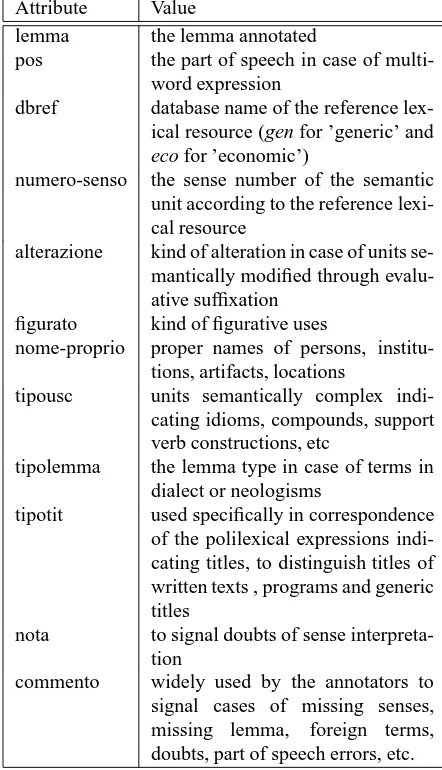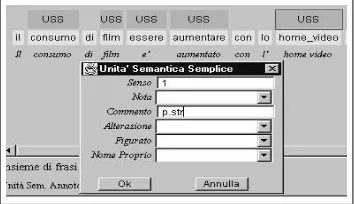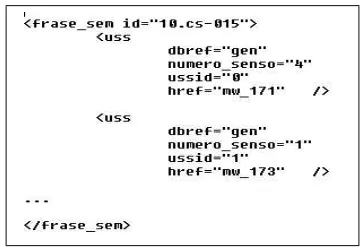Figure 1: A view of the main GesTALt window
account other relevant works in the literature on semantic annotation for other languages.
Three kinds of semantic units have been annotated: 1. uss (unit`a semantica semplice - ’simple semantic
unit’): sense units that correspond to single lexical items (e.g. prezzo ’price’; politica ’politics’; palazzo ’palace’);
2. usc (unit`a semantica complessa - ’complex semantic unit’): semantically complex units expressed in terms of multi-words, as compounds (e.g. consiglio di am-ministrazione lit. ’board of directors’), support verb constructions (e.g. fare paragoni lit. ’to make com-parisons’ in the meaning of ’to compare’), idioms (e.g. ’prendere due piccioni con una fava’ lit. ’to take two pigeons with a broad bean’ corresponding to the En-glish expression ’to kill two birds with one stone’); 3. ust (unit`a semantica titolo - ’title semantic unit’):
sense units that correspond to titles of newspapers (e.g. La Repubblica, Il Sole 24 Ore, Il Corriere della Sera, etc.), books (e.g. Il nome della rosa, La Divina Com-media, Pinocchio, etc.), operas (e.g. Le nozze di Fi-garo, La Cenerentola, Don Giovanni).
A different treatment has been defined for the polilexi-cal expressions indicating titles: whereas uss and usc have been annotated at one level only, all ust (e.g. the opera Le nozze di Figaro) have received a two-level annotation (one at the level of individual components and one at the level of the whole unit). With reference to the example above, according to this strategy, nozze and Figaro have been an-notated individually as uss and the whole string Le nozze di Figaro as ust. In this way, we do not preclude the pos-sibility of processing both on the titles and their internal
components5.
2.3. Annotation Procedure
Whereas the syntactic annotations have been performed by a word-by-word approach, the lexico-semantic anno-tation process has been carried out by lemmas: chosen a lemma and verified its possible senses in ItalWordnet, all its occurrences in the corpus have been annotated. In this way more homogeneous and coherent annotations have been guaranteed. This annotation was mostly accomplished by following the criterion of relative frequency within each corpus, i.e. annotating most frequent lemmas first, and so on. The annotation process started from the lemmas shared between the balanced and financial corpora. These lem-mas, decided in accordance with the requirements of the ItalWordNet lexicographers, were chosen in order to allow for an higher stability of the reference lexical resource – the meaning of such lemmas were thoroughly verified before the annotation took place.
Instead of using a semi-automatic approach as de-scribed, for example, by Erdmann et al. (2000), the seman-tic annotation has been carried out manually, with the sup-port of a tool (GesTALt6) specifically developed for build-ing the treebank. As shown in the Figure 1, the access to the lemma listing, ordered alphabetically, is simplify by an appropriate graphical interface.
When the annotator selects an alphabet letter (e.g. the ’g’ letter), the tool shows all lemma starting with that let-ter. When selecting a lemma (e.g. giugno), all
occuren-5
That could be useful, for example, for Information Retrieval tasks, where the queries can regard whole titles but also subparts.
6The GesTALt tool has been designed and developed at
Figure 2: Article from ’Sole 24 Ore’
cies of that lemma in the corpus are shown, splitted in one o more pages (20 occurrencies, and so 20 sentences, per page). In the right part of the tool window, the news num-ber and the sentence containing that lemma are reported. Clicking on the news number (e.g. sole-morph001-4), the whole sentence is visualized on the top of the window. In this way the annotator can see the complete sentence text in which that word is positioned. If the sentence con-text is not enough to understand in which sense the lemma is used, the annotator can look the whole news over simply clicking on the sentence on the right part of the window, at the bottom. In the news text the sentence containing the lemma in examination is easly detectable because it is high-lighted in yellow (see Figure 2).
At this stage, the real annotation phase starts according to the following steps (not rigorously in this order):
to search for the specific lemma in the ItalWordNet lin-guistic resource, and to evaluate the corresponding al-lowable meanings.
to evaluate the context of each word occurrence of the given lemma, in order to obtain a context-dependent sense for the lemma itself. The context is defined by the sentence including the given lemma. In prac-tice, this step consists in reading and analyzing the single lemma with respect to the phrase containing it. Whenever necessary, the previous step is repeated more times increasing the context in order to capture the lemma sense – the reference text may include the corresponding sentence or the paragraph or even the whole article.
to select the text portion to be annotated. It can be the bare lemma, but in other cases it may turn out to be a compound semantic unit. Consider that certain polilexical expressions were already provided in in-put (e.g. box office, ad hoc, in funzione di), and man-aged as compounds from the very beginning, through-out every annotation level. Other cases, featuring a stronger semantic-lexical component (e.g. support verb constructions, idioms, names of persons, compa-nies, manufactures), are explicitly created only at the present level.
to assign a proper meaning (namely sense number) to the semantic unit under consideration (either simple,
Figure 3: Annotation example of a USS
complex, or title), among those considered by Ital-WordNet. If a given lemma or a specific sense is miss-ing in the reference lexical resource, a discussion takes place among the annotation staff members and, if re-quired, the problem is issued to the ItalWordNet staff. If a specific lemma does not appear in the lexicons (neither generic, nor specialistic) due to its limited suitability, the conventional valuenois assigned to the sense attribute. On the contrary, if the lemma has more senses attested in the reference lexical resource and al-lowable in the specific context7, the annotator reports all the good sense numbers, concatenating them with the symbol&(e.g. 1&3).
to enrich the annotation with additional information in order to mark proper nouns, idioms, metaphors, sup-port verbs, etc., as agreed within the treebank staff.
2.4. Some Examples of Annotation
The annotation methodology is here illustrated by some examples, one for each kind of semantic units.
First of all, the Figure 3 shows an example of uss an-notation. In the example the target word is home video (polilexical expression, already provided as a single unit at the morpho-syntactic level) in the context given by the sentence ’il consumo di film `e aumentato con l’home video’ (lit. ’the film consumption increased by means of the home video’). As the annotation window shows, the value1has been assigned to the attributesensobecause the lemma is included into ItalWordNet resource, as foreign term in us-age in the Italian languus-age. The annotator has pointed out that the target word is a foreign word specifyingp.str
(abbreviation of parola straniera ’foreign word’) in the slot
Commento.
Secondly, in Fig. 4 an example of usc annotation is shown. The annotated word is ’pacchetto di controllo’ (lit. ’shareholding’), a multi-word expression, typical of the economical domain. As shown in the annotation window, the annotator has built the usc (see the dark box marked
USC, above the USSboxes which are empty). Then the value no has been assigned to the attribute senso be-cause ItalWordNet did not include that expression (neither
7Consider for example the sentence “un medico mi ha detto
che c’era un problema” lit. ’a doctor said me that there was a
Figure 4: Annotation example of a USC
Figure 5: Annotation example of a UST
in the generic resource nor in the specialized one). How-ever, since the expression is common in the economic lan-guage, the annotator has suggested to add it into the lexi-cal reference resource. In particolar, he/she uses the field
Commentoto mark that the lemma will be object of eval-uation (odv) on the ItalWordNet side and to suggest an in-clusion in the economic lexical resource (+EcoWN). In the same time, the fieldTipois used to specify that the lemma is a compound unit (tipousc).
Finally, an example of ust annotation (Figure 5). The annotated title is ’Settimana in Bulgaria’. It has been anno-tated at two levels: at the first one, the single constituting units (settimana and Bulgaria) have been tagged according to their individual sense, as reported in ItalWordNet. At the second level, the title has been treated as a single unit: the annotator has built the complex unit (as the dark box named
USTshows) and marked withtipo=tipotitto indicate that it is a generic title, referring to an event. Obviously, at
ust level the sense number information are missing and so
the attributesensois tagged asno.
3.
Annotation Results
The final output of the lexico-semantic annotation level has been coded in XML format. In order to avoid re-dundancy, the lexico-semantic annotation level is directly linked to the corresponding annotation at the morpho-syntactic one. For example, given the sentence (extracted from Il Corriere della Sera):
Il nome del carabiniere (i corazzieri sono in-fatti un reparto speciale dell’Arma) `e “top seg-ret”, ma la vicenda `e stata denunciata alla mag-istratura e il procuratore militare Antonino In-telisano ha aperto un’inchiesta per il reato di offesa all’onore del Presidente della Repubblica.
Figure 6: XML representation of a text example annotated morpho-syntactically
Figure 7: XML representation of a text example annotated at lexico-semantic level
there is a XML representation of both the morpho-syntactic annotation (see Figure 6) and the corresponding lexico-semantic annotation (Figure 7).
At the semantic level the annotated lemmas (e.g. nome and carabiniere) are not esplicitly included in the XML representation, but they are simply linked to the morpho-syntactic level by the reference identifier (i.e.mw 171and
mw 173respectively).
The Table 2 summarizes the results concerning the lexico-semantic annotation, achieved within the SI-TAL project, in terms of number of annotated semantic units. Globally 81,236 content word occurencies have been anno-tated, so distributed: 65,141 uss - 4,548 usc - 283 ust.
M. Marcus, M. A. Marcinkiewicz, and B. Santorini. 1993. Building a large Annotated Corpus of English: the Penn Treebank. Computational Linguistics, 19(2):313–330. M.C. McCord. 1990. Slot Grammar: A System for
Sim-pler Construction of Practical Natural Language Gram-mars. Computer Science, pages 118–145.
S. Montemagni, F. Barsotti, N. Calzolari, O. Corazzari, A. Zampolli, F. Fanciulli, M. Massetani, R. Raffaelli, R. Basili, M. T. Pazienza, D. Saracino, F. Zanzotto, N. Mana, F. Pianesi, and R. Delmonte. 2000. ing the Italian Syntactic-Semantic Treebank. In Build-ing and usBuild-ing syntactically annotated corpora. Kluwer, Dordrecht.
A. Moreno, A. Lopez Ruesga, S. Sanchez Leon, and F. Sanchez. 2000. Spanish Treebank: Specifications. In Building and using syntactically annotated corpora. Kluwer, Dordrecht.
A. Roventini, A. Alonge, F. Bertagna, B. Magnini, and N. Calzolari. 2000. ItalWordNet: a Large Semantic Database for Italian. In Proceedings of LREC-2000, Sec-ond International Conference on Language Resources and Evaluation, pages 783–790, Athens, Greece. W. Teubert. 1995. Language Resources: The Foundations




